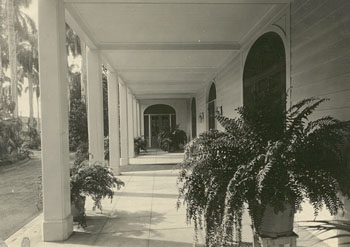This spot was formerly called Kalehuawehe. The surf break ‘Castles’ is named after the Castle family’s four-story beachfront home.
In 1837, Samuel Northrup Castle arrived in Honolulu as a missionary. He left Hawaiʻi for a short time then returned as a businessman for the mission. With Amos Cooke, he founded Castle & Cooke Company in 1851 – it grew into being one of Hawaiʻi’s “Big Five” companies.
One of his ten children would surpass him as a businessman. James Bicknell Castle was born November 27, 1855 in Honolulu to Samuel and Mary (Tenney) Castle. He attended Punahou School 1867–1873, and then Oberlin College.
Castle acquired property in Waikīkī; it had been the home of Boki, the governor of O’ahu, and his wife Liliha. In 1899, James B. Castle built his Waikīkī home and called it ‘Kainalu.’ It was a lavishly furnished four-story mansion with extensive grounds, an ocean pier and other amenities.
In business, he greatly expanded Castle & Cooke in the sugar and railroad industries. One of his first moves was in 1890 when Lorrin Thurston and others joined to create the Kahuku Plantation Company on land subleased from Benjamin Dillingham.
Castle is credited with winning control of the Hawaiian Commercial & Sugar Company from Claus Spreckels in 1898, which he sold to Alexander & Baldwin for a large share of their stock. He later bought large amounts of land, such as Kāneʻohe Ranch.
He then moved to his next phase of his work, which was to connect the Dillingham’s Oahu Railway & Land Co. (OR&L) in Kahuku with the proposed street railway system in Honolulu by way of the Windward Coast.
His plan was to extend his Koʻolau Railroad Co. south of Kahana Bay through Kāneʻohe and Kailua, and on to Waimanalo where it would go through a tunnel and into Manoa Valley and connect with the Rapid Transit & Land Co.
Unfortunately, he died in 1918 before the project could be completed; however, he ran the line from Kahuku to Kahana Bay and extended his plantation and used this railway to haul it to the Kahuku mill. The train service completely closed down by 1952.
When Castle died, his widow found the beachfront property more than she wished to keep up. Mrs. James B. Castle was impressed by the charitable work being done by the Elks (the Honolulu Elks Lodge 616 was established on April 15, 1901) and in 1920 sold them 155,000 square feet on the beach at Waikīkī complete with lavish home, for $1 a square foot.
For decades, the Elks membership and officers worked to raise funds to pay off the mortgage. Every possible method of raising funds was tried. Elks held carnivals, “smokers,” baseball matches, boxing matches, theatricals, auctions, circuses, concerts and dances.
Funds were raised for charity, and a bit set aside to retire the mortgage. Finally, on March 3, 1943, as members sang “Auld Lang Syne;” the mortgage was burned with great ceremony.
Several times since 1920 the sale of the property was proposed and even authorized, but motions were defeated or rescinded. Most prominent was a protracted discussion with the Outrigger Canoe Club, which was looking for a new home.
Between 1954 and 1956, Outrigger Canoe Club made several offers to purchase about half the Castle property. All were refused. Eventually, in 1955, the Elks agreed to lease property to Outrigger. Negotiations continued, and a lease was signed effective November 17, 1956.
In 1958 the Lodge determined to raze Kainalu and rebuild a new lodge. After an April gala aloha event, the old Lodge was demolished in June of 1959. Ground breaking for the new building took place on August 17, 1959. On June 20, 1960, the first meeting was held in a new building, the present lodge building.
In the sand, constantly washed by the waves, are 6 flat-topped black basalt rocks set in cement. The rock is said to come from the Kaimuki Quarry. Also visible is one round, bowl-shaped object. These are the last remnants of the James Castle home.
The multi-sided stones were the footings for pillars holding up the Castle home’s dining room. Facing the ocean, 9 tubular wooden pillars sat on the round cement footings, and in the rear a second row of heavier pillars sat on the lava rock.
In 2007, a rent dispute between the Elks Lodge and Outrigger Canoe Club was settled by a three-member arbitration panel. Terms of the new rent between the next-door neighbors were not disclosed because of a confidentiality agreement (the Elks Lodge, the landowner, was seeking up to $1 million or more a year in rent from the canoe club for a 99-year lease that was renegotiated midway through the term.)
James Castle and his wife had one child, Harold Castle; in the form of various gifts, Harold Castle is the man behind Castle Hospital, Castle High School, Kainalu Elementary, Central Union Windward Church and the Windward Branch of Hawaiʻi Pacific University.
Follow Peter T Young on Facebook
Follow Peter T Young on Google+
Follow Peter T Young on LinkedIn
Follow Peter T Young on Blogger




































































